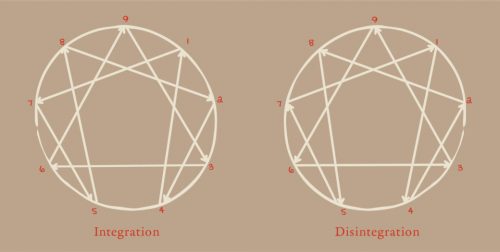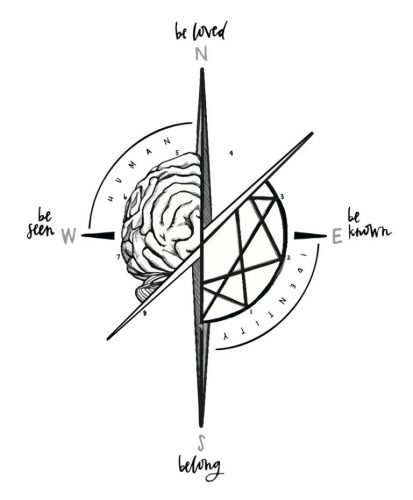Enneagram Part Three: Head Center
A Dynamic Symbol
Monday,
March 9, 2020
One of the most confusing aspects of the Enneagram can be the nine lines and “arrows” that seem to crisscross the Enneagram symbol but are the basis of its foundation and wisdom. In The Sacred Enneagram, Chris Heuertz explains what these lines mean:

One fundamental component of understanding [Enneagram] type involves the lines [and arrows] within the Enneagram’s symbol. These crisscrossing lines show us the movement of our type when operating in a healthy or unhealthy state.
There are several schools of thought about the traversing of lines inside the Enneagram, each with diverging philosophies regarding their implications. For instance, the Enneagram Institute refers to the lines as the directions of integration and disintegration; the Enneagram in the Narrative Tradition refers to them as our Security Types and Stress Types; the Chilean grandfather of the modern Enneagram, Claudio Naranjo, used the language Heart Points and Stress Points; and H. A. Almaas originated the notion of the Soul Child, which Father Richard [Rohr] and Sandra Maitri continued to develop. [1]
These are all different ways of describing the dynamic of each type as it presses into growth or reverts to patterns of self-sabotage. This is where we encounter the uniqueness of the Enneagram as a character-structure construct: it offers both a portrait of healthy and a portrait of unhealthy for each type, and prompts us to identify honestly where we are functioning on that spectrum. This might vary from day to day or even hour to hour, but the gift presented to us is greater awareness that leads to psychological and spiritual growth. . . .
Integration or security allows our dominant type to borrow the positive traits of another type. For example, a healthy person dominant in type One integrates or borrows some of the positive traits of type Seven by relaxing their inner drive for perfection and allowing themselves to become a little playful and spontaneous. . . .
When they lose themselves . . . Ones disintegrate toward the Four . . . [and] believe their own lie that they alone are the only ones who understand and value excellence—that no one else has the capacity to grasp what is required for goodness to be actualized in the world.
A newer theory that I happen to agree with is that our path of disintegration is that innate self-survival reflex that stops our fall by reaching out to the lower-level manipulation techniques of another type as a way of getting our attention—letting us know we are falling and if we don’t catch ourselves we’ll “break our arm” or worse.
While it is helpful to see the full picture of the type from which we borrow in health, the key for all of us is to focus on health and growth in our [own] dominant type. To recognize ourselves in integration requires that we accept the best of ourselves in our dominant type. . . .
Giving ourselves to this path requires a disciplined cultivation of spiritual depth accessible only through faithful contemplative practice that brings us into the transforming presence of a loving God.
Enneagram Part Three: Head Center
Two Sides of the Coin
Sunday, March 8, 2020
If taken seriously and used responsibly, the Enneagram is a tool that can help us move from dualistic thinking to nondual consciousness. It helps us recognize and forgive the paradoxes that we all carry, what we might call our “sins.” The Enneagram shows us how we continually do things we don’t want to do (our fixations, passions, and patterns) and can’t quite seem to do the things we want (see Romans 7:15-20).
But the Enneagram also insists that our virtue and our passion are two sides of one coin. The way to find our unique gift is often through our flaws. And the way to discover our flaws is often through our gift. Who would have thought?
Eventually we have to admit that our mistakes and failures (our “sins”) are our greatest teachers. The Enneagram taught me that like nothing else in my life. It taught me that I’m a living paradox. For the first half of my life, even with my theological training and maybe even because of it, I largely denied that split or avoided it by confessing my sins too quickly—making them something “out there” I could get rid of instead of something “in here” from which I could learn.
Most Christians were trained to think that we would be punished for our sins, but I’ve come to believe we are punished by our sins. The Enneagram helps me to recognize the punishment I’m inflicting on myself when I remain unconscious of the fears and judgments that drive my behavior. When I am not in honest relationship and present to my whole self, I am much further away from the Divine Presence who forgives everything.
The work of spirituality is to make our presence to Presence possible by keeping the heart space open (through love), the mind space right (through contemplation), and the body resting in the present moment. Those who are alert and awake in all these three centers of Intelligence at once can experience Presence. The Enneagram points out nine particular ways we avoid being present in the moment.
If we deny or eliminate the mysterious, problematic, negative, or wounded parts of ourselves or pretend they’re not there, I don’t think we can relate to God very well, because we will also deny and hide from the mysterious and vulnerable nature of God.
For me, the Enneagram is about as good a tool as I can find to reveal that we are living contradictions and we always will be. Don’t try to overcome your contradictions! Learn from them. Amazingly, that is what makes us compassionate, merciful, forgiving, sensitive, open-hearted, bridge-building people.
It’s all about love. It’s not about moral achievements. The goal of the entire spiritual journey is union in love. And love is not achieved by any performance principle, but it is something we “fall into” when we are not in full control.
Enneagram Part Two: Heart Center:
Summary: Sunday, March 1–Friday, March 6, 2020
Through the lens of the Enneagram we have greater self-knowledge and the ability to let go of what only seems good in order to discover what in us is really good. (Sunday)
Something is clearly working here, and the enneagram of personality movement seems to be manifesting the fruits of conscious inner work in ways that are both personally authentic and statistically significant. —Cynthia Bourgeault (Monday)
Being in touch with the heart tells us the quality of our existence, tells us how we recognize the truth. . . . The heart also is the place where we know who we really are. —Russ Hudson (Tuesday)
Twos are healed and redeemed the more they experience God as the Real Lover and realize that true, selfless love only comes by sharing in God’s love. (Wednesday)
At their healthiest, Threes let go of the belief that their value is dependent on the positive regard of others, thus freeing them to discover their true identity and their own heart’s desire. —Don Richard Riso and Russ Hudson (Thursday)
At this [healthy] stage, Fours no longer need to feel different or special, seeing that, indeed, the universe has created only one of them, and that they are part of everything else—not isolated and alone. —Don Richard Riso and Russ Hudson (Friday)
Practice: The Brain-Based Enneagram
This week’s invitation to contemplative practice is again drawn from Whole-Identity: A Brain-Based Enneagram Model for (W)holistic Human Thriving, by Living School student Dr. Jerome Lubbe. It is certainly a different way of understanding the Enneagram than I was taught so many years ago, but while the symbol is ancient and perennial, the wisdom is continually evolving, just like we should be.

“What is your number?” is the most frequently asked question in regard to the Enneagram. But in the Brain-Based model, we learn to see ourselves as all nine numbers simultaneously, and to consider our efficiency in each. For example, instead of “I am a One” you might say, “I have high efficiency in One,” and then perhaps, “my Seven nature is strong as well.” That means if you tested as a One you would not “be” a One but instead would have high efficiency” in the nature of One. When that is the case, you can further inquire, “. . . and what is my relationship to the rest of the numbers/natures?” All around the circle, you witness the efficiency or inefficiency with which you utilize each number and paint a more (w)holistic picture of your personal neuropsychology.
Efficiency in a number means there is an ease of relationship with the nature of that number. It means you engage often. Efficiency by definition is, “accomplishing a task with the least amount of allocated resources and energy required.” It is important to understand this is not an indication of health, but of ease of use. Someone who enjoys autonomy is going to have a high efficiency in Eight, but that doesn’t mean they are an Eight. They’re multi-faceted. For instance, perhaps they also value clarity and authenticity, so they’re efficient in Five and Four nature(s) as well. The analysis should be applied to all nine numbers for a more integrated perspective of the whole.
Inefficiency in a number means there is less ease in the relationship with the nature of that number. You don’t often engage. . . . Accomplishing tasks related to inefficient number/natures requires increased allocation of resources and utilizes a significant amount of energy. Imagine the same person who is efficient in Eight struggles to see the value of serenity. . . . They are likely inefficient in Six and Nine. Instead of turning Six and Nine away as irrelevant, they can instead expand their capacity. . . .
Every single person has access to all nine numbers. Based on nature, nurture, and discipline, you express the values of each number at varying degrees of intensity based on your lived experience.
You are not one thing; you are complex and multifaceted; you are interconnected. This is a vital paradigm shift. When you consider having access to all nine numbers simultaneously, you increase and expand your capacity for thriving. [1]
Considering what you know of the Enneagram so far, in what numbers do you experience ease, or in Lubbe’s language, sense “efficiency”? Where do you feel less efficient? As a reminder, here are the values Lubbe identifies (as alternatives to “I am” statements):
Eight: I value Autonomy
Nine: I value Serenity
One: I value Justice
Two: I value Appreciation
Three: I value Authenticity
Four: I value Creativity
Five: I value Clarity
Six: I value Guarantees
Seven: I value Experiences [2]